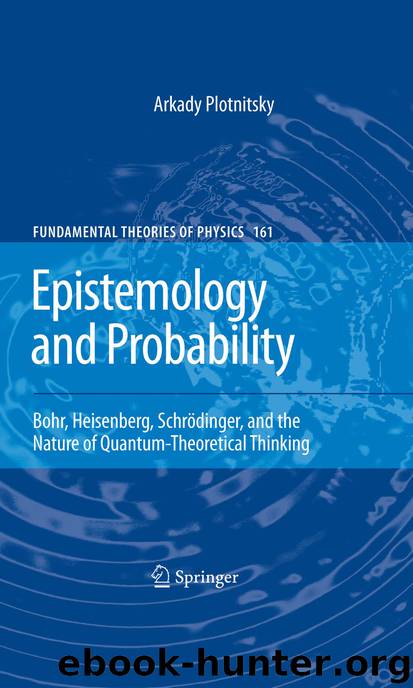Epistemology and Probability by Arkady Plotnitsky

Author:Arkady Plotnitsky
Language: eng
Format: epub
Publisher: Springer New York, New York, NY
6.2 The Quantum Postulate: Discontinuity and Irrationality
Bohr appears to have formulated the concept of the quantum postulate in the Como lecture.3 Underscoring the centrality of this concept for Bohr’s argument there is the fact that it serves as Bohr’s title concept, indeed the single physical concept of the title, “The Quantum Postulate and the Recent Development of Atomic Theory.” The significance of the concept has never diminished in Bohr’s work (although the phrase itself became infrequent in his writings), even as other concepts, beginning with complementarity, moved to center stage and changed the conceptual architecture of the quantum postulate itself. Bohr’s work on complementarity may also be seen as a lifelong effort to give the proper meaning to “the quantum postulate” and, thus, to “Planck’s discovery of the elementary quantum of action,” the phrase Bohr uses throughout his works beginning with his 1929 article, “The Quantum of Action and the Description of Nature” (Bohr 1929a, PWNB 1, p. 92; emphasis added). Although Bohr often speaks of the quantum postulate as Planck’s quantum postulate, his interpretation or, again, conception of it makes the postulate his own. Associating the postulate with Planck is of course well justified. From the point of Planck’s discovery of his black body radiation law, quantum discontinuity, reflected in the quantum postulate, becomes a defining part of our understanding of the ultimate constitution of nature. In “Atomic Theory and Mechanics” (Bohr 1925b, PWNB 1, pp. 25–51), completed in the wake of Heisenberg’s introduction of quantum mechanics, there is no “quantum postulate” yet, and the only relevant feature involved is discontinuity. Bohr speaks of Planck’s discovery as “demand[ing] an element of discontinuity of atomic processes quite foreign to the classical theory” (Bohr 1925b, PWNB 1, p. 28). By the time of the Como lecture, however, the quantum postulate assumes a central position in Bohr’s thinking. It is seen by Bohr as expressing the very essence of quantum theory, which, Bohr says, “is characterized by the acknowledgment of a fundamental limitation in the classical physical ideas when applied to atomic phenomena.” “The situation thus created,” he adds, “is of a peculiar nature, since our interpretation of the experimental material rests essentially upon the classical concepts” (Bohr 1927, PWNB 1, p. 53). These statements reveal the complexity of Bohr’s view on the role of the classical concepts (not the same as “classical physical ideas,” which refers to the ways these concepts are to be used) as essential and yet limited and, as concerns quantum objects and their behavior, even inapplicable.
The quantum postulate itself reflects or symbolizes this situation. According to Bohr: “Notwithstanding the difficulties which, hence, are involved in the formulation of the quantum theory, it seems, as we shall see, that its essence may be expressed in the so-called quantum postulate, which attributes to any atomic process an essential discontinuity, or rather individuality, completely foreign to the classical theories and symbolized by Planck’s quantum of action” (Bohr 1927, PWNB 1, p. 53). Bohr’s hesitation (“or rather”) is worth noting, as
Download
This site does not store any files on its server. We only index and link to content provided by other sites. Please contact the content providers to delete copyright contents if any and email us, we'll remove relevant links or contents immediately.
| Anthropology | Archaeology |
| Philosophy | Politics & Government |
| Social Sciences | Sociology |
| Women's Studies |
The remains of the day by Kazuo Ishiguro(8820)
Tools of Titans by Timothy Ferriss(8218)
Giovanni's Room by James Baldwin(7189)
The Black Swan by Nassim Nicholas Taleb(7010)
Inner Engineering: A Yogi's Guide to Joy by Sadhguru(6725)
The Way of Zen by Alan W. Watts(6505)
Asking the Right Questions: A Guide to Critical Thinking by M. Neil Browne & Stuart M. Keeley(5632)
The Power of Now: A Guide to Spiritual Enlightenment by Eckhart Tolle(5605)
The Six Wives Of Henry VIII (WOMEN IN HISTORY) by Fraser Antonia(5394)
Astrophysics for People in a Hurry by Neil DeGrasse Tyson(5131)
Housekeeping by Marilynne Robinson(4344)
12 Rules for Life by Jordan B. Peterson(4250)
Double Down (Diary of a Wimpy Kid Book 11) by Jeff Kinney(4207)
The Ethical Slut by Janet W. Hardy(4173)
Skin in the Game by Nassim Nicholas Taleb(4162)
Ikigai by Héctor García & Francesc Miralles(4125)
The Art of Happiness by The Dalai Lama(4063)
Skin in the Game: Hidden Asymmetries in Daily Life by Nassim Nicholas Taleb(3929)
Walking by Henry David Thoreau(3893)
